| Author |
Message |
|
Matthew Harrington
|
 Posted: Thu 15 Nov, 2012 7:12 am Post subject: Vendel Era to Viking Age Comparison Posted: Thu 15 Nov, 2012 7:12 am Post subject: Vendel Era to Viking Age Comparison |
 |
|
I was just curious as too why the attention to detail between Vendel Era and Viking Age artifacts differ so greatly, It seems like Vendel era artifacts are extremely detailed and very well made, while viking age artifacts may be made just as well, it seems the detail and work going into the sword or helmet is significantly less. Is there any reason for this?
 Attachment: 130.52 KB Attachment: 130.52 KB
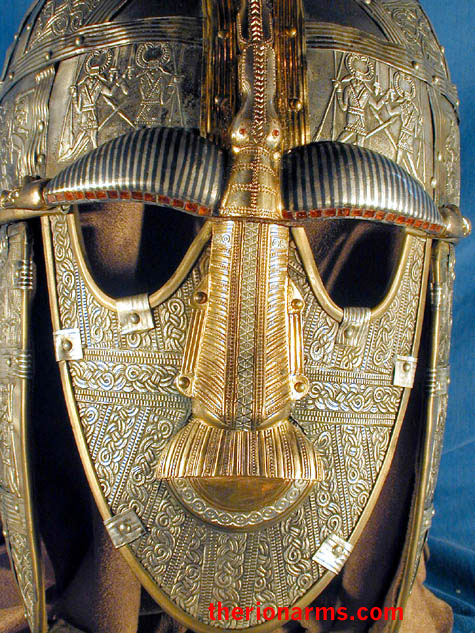
Sutton Hoo Helmet
 Attachment: 9.11 KB Attachment: 9.11 KB
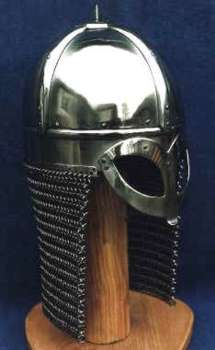
Gjermundbu Helmet
 Attachment: 46.37 KB Attachment: 46.37 KB
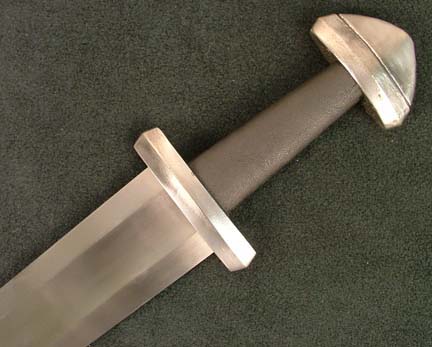
Viking Age Sword (Type H)
 Attachment: 243.73 KB Attachment: 243.73 KB
Vendel/Migration Era Sword [ Download ]
|
|
  |
 |
Petr Florianek
Industry Professional

|
 Posted: Thu 15 Nov, 2012 8:12 am Post subject: Posted: Thu 15 Nov, 2012 8:12 am Post subject: |
 |
|
Hello!
While i admit that there might be a realistic root of your question, i find the way how you asked very unfortunate.
why?
you operate with images in your post, but those images are of the replica, or may be interpretations, and sometimes not very good.
and if you were trying to compare orinals, why compare a royal spatha and plain H type hilt?
if you choose spatha, why not compare it with S type hilts from Hedeby, fully overlayed in silver and copper?
why not to mention silver overlayed socketed spears with mammen and ringerikke design, which when new shined like icicles of death?
but to answer partly your question:
i think that the difference which we see in richness of the stuff, is by my opinion caused by wealt accummulation. As for Vendel period, the metal of trade and loot was gold, the wealth was probably more concentrated...
|
|
   |
 |
Craig Peters

|
 Posted: Thu 15 Nov, 2012 8:18 am Post subject: Re: Vendel Era to Viking Age Comparison Posted: Thu 15 Nov, 2012 8:18 am Post subject: Re: Vendel Era to Viking Age Comparison |
 |
|
| Matthew Harrington wrote: | | I was just curious as too why the attention to detail between Vendel Era and Viking Age artifacts differ so greatly, It seems like Vendel era artifacts are extremely detailed and very well made, while viking age artifacts may be made just as well, it seems the detail and work going into the sword or helmet is significantly less. Is there any reason for this? |
Matthew,
It could be more to do with the artifacts you chose as representative than the eras themselves. Wikipedia quotes David M. Wilson as saying that the metal artworks found in the Sutton Hoo graves were "work of the highest quality, not only in English but in European terms".[51] This suggests that the Sutton Hoo helmet is very much an atypical find, rather than the norm.
The Viking sword you have shown is comparatively austere when looking at other Viking era weapons. You might look around myArmoury; there are examples of Viking swords far more ornate than the one you've posted.
|
|
  |
 |
|
Matthew Harrington
|
 Posted: Thu 15 Nov, 2012 8:27 am Post subject: Posted: Thu 15 Nov, 2012 8:27 am Post subject: |
 |
|
|
Yeah you're right I suppose I didn't fairly way the options, I've seen some viking age work just as nice as the sutton hoo and other vendel finds, but it just seems there's less detailed/ornate viking finds. How did they accumulate more wealth and what made them less wealthy during the viking age? More people? Bad taxes and such by tyrant rules like Harald Fairhair? On another note, I think 9th century Oslo design patterns are probably my favorite out of the nordic art. I love the Hedeby finds, didn't someone make a replica of this with single edged blade?
|
|
  |
 |
|
Matthew Harrington
|
 Posted: Thu 15 Nov, 2012 8:33 am Post subject: Re: Vendel Era to Viking Age Comparison Posted: Thu 15 Nov, 2012 8:33 am Post subject: Re: Vendel Era to Viking Age Comparison |
 |
|
| Craig Peters wrote: | It could be more to do with the artifacts you chose as representative than the eras themselves. Wikipedia quotes David M. Wilson as saying that the metal artworks found in the Sutton Hoo graves were "work of the highest quality, not only in English but in European terms".[51] This suggests that the Sutton Hoo helmet is very much an atypical find, rather than the norm.
The Viking sword you have shown is comparatively austere when looking at other Viking era weapons. You might look around myArmoury; there are examples of Viking swords far more ornate than the one you've posted. |
You're right, I could've chosen much better examples, bad call on my part, but I don't know much about Vendel era weapons, I knew the Sutton Hoo find is the most famous, I thought many were like it, but I was mistaken it seems.
A better comparison might have been the sword found in a women's grave in Suontaka, TyrvšntŲ, Tavastland, Finland.
|
|
  |
 |
John Wills

Location: Northamptonshire UK Joined: 20 Jun 2012
Posts: 10
|
 Posted: Thu 15 Nov, 2012 12:18 pm Post subject: Posted: Thu 15 Nov, 2012 12:18 pm Post subject: |
 |
|
I would suggest you look for the following books "Woden's Warriors" by Paul Mortimer and "Wayland's Work" by Stephen Pollington for a wide range of Anglo-Saxon and Vendel goodies. There are a number of spectacle helms from Valsgarde with similar pressblechs and grandeur to that from Sutton Hoo which have been reproduced and worn by the Wulfheodenas and Ulfhednar.
It is correct that the ornament of weapons and armour reduced between the 8th and 10th centuries amongst the Germanic peoples; you must also remember that the conversion to Christianity also took place during this period. The early English and the Vendel highly ornament stuff is from the Heathen period when the symbolism of the designs was as protective as the actual gear, if not more so in the eyes of the wearer. After the arrival of Christianity the "magical" effects of the designs was no longer required, this is somewhat illustrated by comparing the Wollaston helmet with the Coppergate helmet which are almost identical in overall shape however the boar crest (a protective totem of Ing/Yngui-Freyr) is replaced with the Latin text "IN. NOMINE. DNI. NOSTRI IHV. SCS. SPS. D. ET. OMNIBUS DECEMUS. AMEN. OSHERE. XPI." (in the name of our Lord Jesus, the Holy Spirit, God and all, we pray. Amen. Oshere. Christ). I discuss this in a short paper available at http://www.academia.edu/2060398/Some_Animal_I..._Heathenry , also a good paper to read is "Symbols of Protection: The Significance of Animal-ornamented Shields in Early Anglo-Saxon England" by Tania Dickinson available at http://eprints.whiterose.ac.uk/1831/1/dickinsont2.pdf
grim guūplega, śr we gofol syllon!
|
|
  |
 |
Robin Smith

|
 Posted: Thu 15 Nov, 2012 12:32 pm Post subject: Posted: Thu 15 Nov, 2012 12:32 pm Post subject: |
 |
|
That Albion is not really representative of what the majority of Type H hilts look like. Albion choose to recreate that one because it could be done and remain within their production cost window. Many Viking Hilts are much more elaborate...
For example:
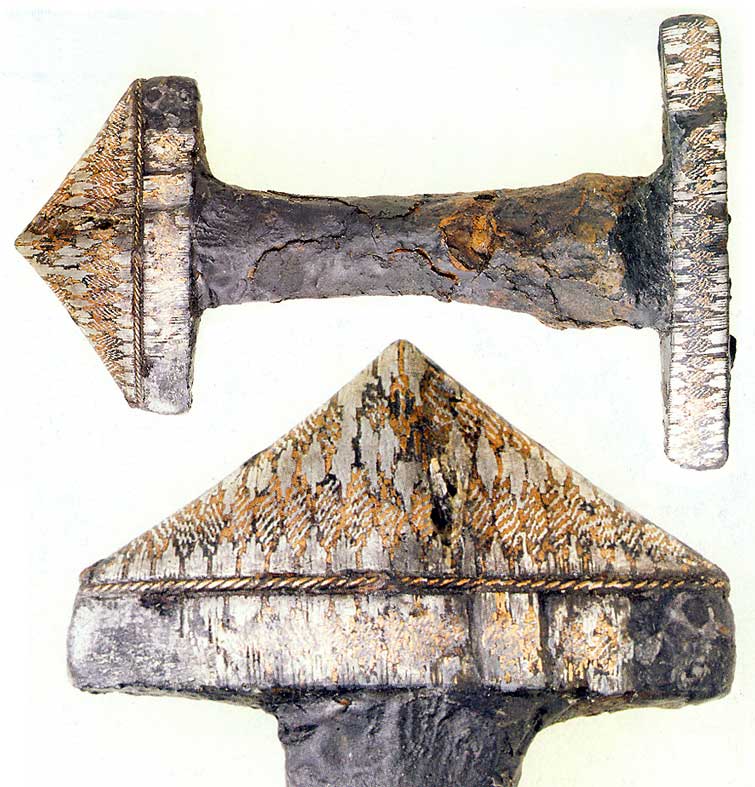
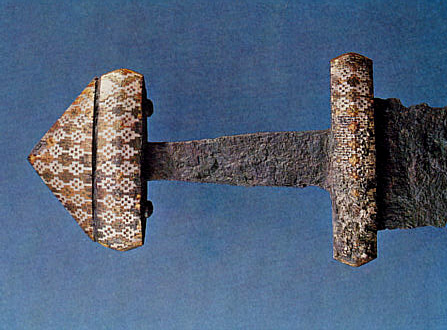
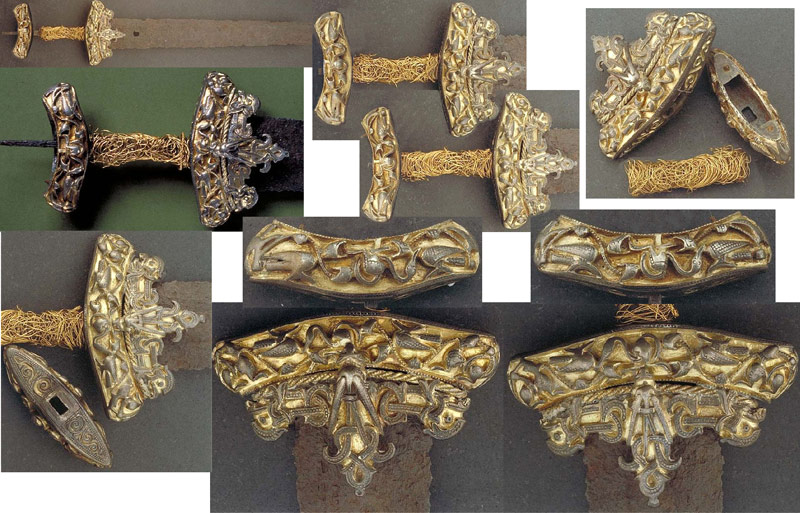
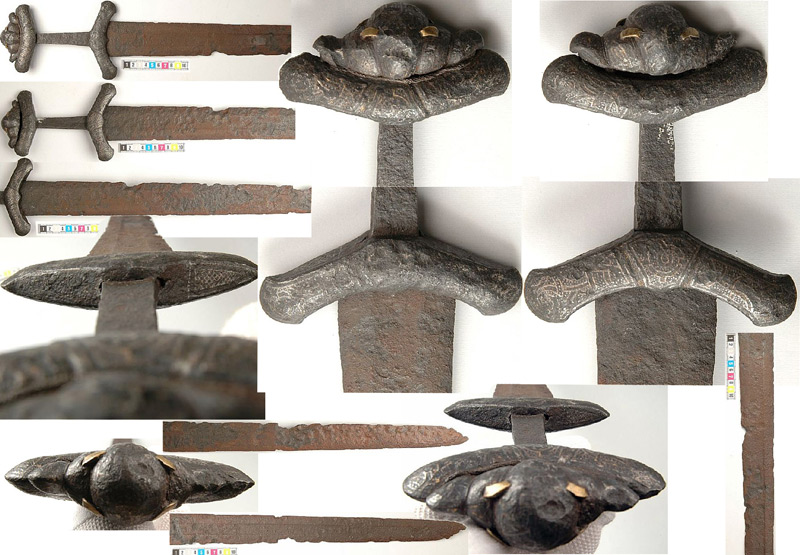
A furore Normannorum libera nos, Domine
|
|
   |
 |
|
Matthew Harrington
|
 Posted: Thu 15 Nov, 2012 4:52 pm Post subject: Posted: Thu 15 Nov, 2012 4:52 pm Post subject: |
 |
|
| Robin Smith wrote: | | That Albion is not really representative of what the majority of Type H hilts look like. Albion choose to recreate that one because it could be done and remain within their production cost window. Many Viking Hilts are much more elaborate... |
Very cool, I've seen ones like your 1st and 2nd picture on Hurstwic before, very cool patterns. What is the 3rd sword though? It's remarkably detailed and correct me if I'm wrong the 4th is a type Z form Gotland, right? I didn't know that sword even had etch/inlay work.
| John Wills wrote: |
I would suggest you look for the following books "Woden's Warriors" by Paul Mortimer and "Wayland's Work" by Stephen Pollington for a wide range of Anglo-Saxon and Vendel goodies. There are a number of spectacle helms from Valsgarde with similar pressblechs and grandeur to that from Sutton Hoo which have been reproduced and worn by the Wulfheodenas and Ulfhednar.
It is correct that the ornament of weapons and armour reduced between the 8th and 10th centuries amongst the Germanic peoples; you must also remember that the conversion to Christianity also took place during this period. The early English and the Vendel highly ornament stuff is from the Heathen period when the symbolism of the designs was as protective as the actual gear, if not more so in the eyes of the wearer. After the arrival of Christianity the "magical" effects of the designs was no longer required, this is somewhat illustrated by comparing the Wollaston helmet with the Coppergate helmet which are almost identical in overall shape however the boar crest (a protective totem of Ing/Yngui-Freyr) is replaced with the Latin text "IN. NOMINE. DNI. NOSTRI IHV. SCS. SPS. D. ET. OMNIBUS DECEMUS. AMEN. OSHERE. XPI." (in the name of our Lord Jesus, the Holy Spirit, God and all, we pray. Amen. Oshere. Christ). I discuss this in a short paper available at http://www.academia.edu/2060398/Some_Animal_I..._Heathenry , also a good paper to read is "Symbols of Protection: The Significance of Animal-ornamented Shields in Early Anglo-Saxon England" by Tania Dickinson available at http://eprints.whiterose.ac.uk/1831/1/dickinsont2.pdf |
Wow, what a well of info, looks like I've got some reading to do, thanks John. 
|
|
  |
 |
Robin Smith

|
 Posted: Thu 15 Nov, 2012 5:57 pm Post subject: Posted: Thu 15 Nov, 2012 5:57 pm Post subject: |
 |
|
| Matthew Harrington wrote: | | Robin Smith wrote: | | That Albion is not really representative of what the majority of Type H hilts look like. Albion choose to recreate that one because it could be done and remain within their production cost window. Many Viking Hilts are much more elaborate... |
Very cool, I've seen ones like your 1st and 2nd picture on Hurstwic before, very cool patterns. What is the 3rd sword though? It's remarkably detailed and correct me if I'm wrong the 4th is a type Z form Gotland, right? I didn't know that sword even had etch/inlay work. |
The 3rd sword was found at Dyback Sweden and is now housed at the Museum of Stockhold.
The 4th is a type Z, but I don't think it is from Gotland. I see the find place listed as Bengtsarvet Haradsarvet Sweden.
Actually the many of the type Z's have some kind of inlay.
A furore Normannorum libera nos, Domine
|
|
   |
 |
|
Gregory J. Liebau
Location: Dinuba, CA Joined: 27 Nov 2004
Posts: 669
|
 Posted: Thu 15 Nov, 2012 6:03 pm Post subject: Posted: Thu 15 Nov, 2012 6:03 pm Post subject: |
 |
|
To throw out a bit of conjecture myself, based upon my historical acquaintances with these cultures, which I admit is slim compared to their Continental neighbors, so excuse me for any faulty logic or inaccurate statements.
The 'Viking' peoples, who proceeded from the Vendels and their contemporary Scandinavians, went a-viking due to particular social, climactic and demographic factors. There's no time to get into it all, but it's fair to say that overpopulation in the North, based upon issues of low resources, particularly in arable land, was a major factor. Men who became professional warriors and decided to escape their poverty by murdering, stealing and selling themselves to others for mutual benefits had very little morality when it came to the accumulation of wealth. It made their war bands more powerful, their longboats faster and larger, and their prestige greater. They could be lucky enough to become kings. With such a concentration and importance on gaining wealth to entertain the armed forces for leaders, it's natural to assume that wealth trickled down as an important sign of a warrior's value within the group. Those warriors wearing the fanciest stuff could show off that they were rewarded by the leader for their work, or else had their own independence from the group among his own people. The valuables they took could constitute almost every ounce of their wages, and was used for buying everything they needed in turn, from swords to beverages to lodging.
With this in mind, I think we have to assume that grave robbing was probably something that occurred frequently during the period by either these men, or those who wished to become like them. Even if the weapons and armor were rusted to uselessness, the great amounts of gold and silver accessories would be well worth the effort to dig guys up. Take the Oseberg ship burial dating from 834, which had almost no precious metals associated with the modern find because they were apparently stolen in earlier times. In my opinion, this was most likely to happen when people could still recognize the grave site, i.e. probably not terribly long after... It happened!
Consequently, taking my last point into consideration, we may find a higher percentage of Vendel goods of high quality because a greater number of their grave sites went unmolested by contemporaries prior to the advent of landless war bands, and were already forgotten by the Viking era plunderers.
Just a thought.
-Gregory
|
|
  |
 |
Olov Tidemalm

|
 Posted: Fri 16 Nov, 2012 1:58 am Post subject: Posted: Fri 16 Nov, 2012 1:58 am Post subject: |
 |
|
| Robin Smith wrote: | | Matthew Harrington wrote: | | Robin Smith wrote: | | That Albion is not really representative of what the majority of Type H hilts look like. Albion choose to recreate that one because it could be done and remain within their production cost window. Many Viking Hilts are much more elaborate... |
Very cool, I've seen ones like your 1st and 2nd picture on Hurstwic before, very cool patterns. What is the 3rd sword though? It's remarkably detailed and correct me if I'm wrong the 4th is a type Z form Gotland, right? I didn't know that sword even had etch/inlay work. |
The 3rd sword was found at Dyback Sweden and is now housed at the Museum of Stockhold.
The 4th is a type Z, but I don't think it is from Gotland. I see the find place listed as Bengtsarvet Haradsarvet Sweden.
Actually the many of the type Z's have some kind of inlay. |
Here is more info on the 3rd sword. From what I can see it's on display in the Gold room at Historiska Museet in Stockholm (Swedish Museum of National Antiquities).
http://kulturarvsdata.se/shm/object/html/108809
Here is more on the 4th. It seems it's not on display.
http://kulturarvsdata.se/shm/object/html/836967
|
|
  |
 |
David Huggins

|
|
   |
 |
|
Matthew Harrington
|
 Posted: Sat 17 Nov, 2012 4:08 pm Post subject: Posted: Sat 17 Nov, 2012 4:08 pm Post subject: |
 |
|
Thank David, look interesting.
Thanks to everyone else who replied as well, you guys answered all of my questions I had. 
|
|
  |
 |
|
Ellen Bergwerf
|
 Posted: Wed 05 Dec, 2012 4:38 am Post subject: Vendel periode Posted: Wed 05 Dec, 2012 4:38 am Post subject: Vendel periode |
 |
|
I agree with Ö. Itís not good to use replicaís to analyse a period. I think the Viking age contains a lot of beautyfull details. I will show you one piece Iíve in my one collection.
I think a lot of replicaís are very abstract, itís very important to know what you buy. Also think itís important not always to follow the masses of people all buying the same products.
 Attachment: 52.64 KB Attachment: 52.64 KB
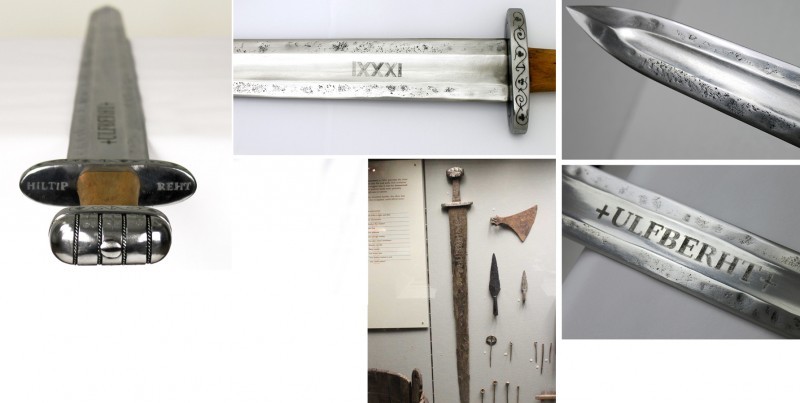
|
|
  |
 |
Josť-Manuel Benito

|
 Posted: Wed 05 Dec, 2012 6:18 am Post subject: Posted: Wed 05 Dec, 2012 6:18 am Post subject: |
 |
|
In the other hand it is very sad to see that horrible ęreplicasĽ of Dybeck viking sword. As you know, in these ęreplicasĽ is wrong added the topmount of the scabbard at the lower guardÖ 
Last edited by Josť-Manuel Benito on Fri 07 Dec, 2012 10:42 am; edited 1 time in total
|
|
    |
 |
|
Ellen Bergwerf
|
 Posted: Wed 05 Dec, 2012 7:34 am Post subject: Vendel periode Posted: Wed 05 Dec, 2012 7:34 am Post subject: Vendel periode |
 |
|
|
Yes, thatís true. But why do everyone want to have a Dybeck sword in the first place. Itís just like I already told, I think itís important not always to follow the masses of people all buying the same products.
|
|
  |
 |
|
Bruce Tordoff
Industry Professional
|
 Posted: Fri 07 Dec, 2012 6:10 am Post subject: Vendel vs Viking Posted: Fri 07 Dec, 2012 6:10 am Post subject: Vendel vs Viking |
 |
|
Matthew,
In case you have any difficulty finding the Dyback sword, it is often referred to as the 'Lund' hilt also.
To echo others, it is a pain that many replicas have used to scabbard mouth piece as part of the lower crossguard, just because it was found stuck together! In case your interested, The Varangaback Pommel (also from Sweden) Is stylistically identical to the Dyback fittings and in my opinion would make the most logical conjectural re construction of this sword.
Now to and my own ten penneth to the thread, I think What John said about the relative differences in art style and its place in weaponry and armour, with respect to the cultural and religious climate of the respective periods, Is pretty much on the money.
I also agree with Robin and Petr. That the differences are relative to the status of the object in question, however that is not to say that there are less objects from the Viking period with beautiful adornment. What is noteworthy is that as the art style changes, certain methods and/or materials seem to fall out of favour, For instance the use of Garnet Cloisonne work, which is prevalent in the Vendel period across various parts of Europe, but eventually drops off in the Viking period.
One point that is very interesting in this context, and may have a correlation with what John said, that, as the amount of 'Richly' decorated fittings and their levels of detail does tail off to some degree regarding swords, seems to drop off even more so regarding helms (as far as the archaeolgical record shows), But if one looks into artifacts of both periods other than weapons and armour, the differences in 'richness' or level of craftmanship are a lot less apparent. Whilst Garnet does vanish for the most part, the other forms of decoration remain, Silver, gold, copper wire inlay still continue. Lost wax cast pieces also continue, with some stunning examples of interlace and very fine granulation and filigree work.
So essentially this may reflect a change to the perception of the people of the period, of the relative importance of weapon and armour decoration, from Pagan to Christian times compared to that of jewellery and civilian attire. Although what Gregory says in his last statement may have a serious part to play, in relative frequency of artifacts of similar quality from both periods.
Bruce
|
|
  |
 |
|
|
You cannot post new topics in this forum
You cannot reply to topics in this forum
You cannot edit your posts in this forum
You cannot delete your posts in this forum
You cannot vote in polls in this forum
You cannot attach files in this forum
You can download files in this forum
|
All contents © Copyright 2003-2025 myArmoury.com — All rights reserved
Discussion forums powered by phpBB © The phpBB Group
Switch to the Basic Low-bandwidth Version of the forum
|

